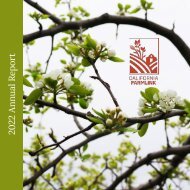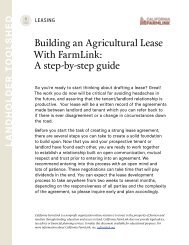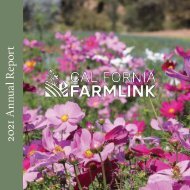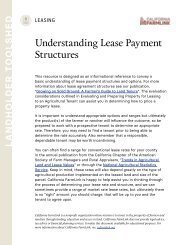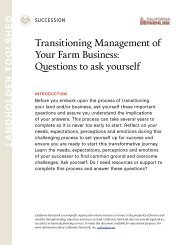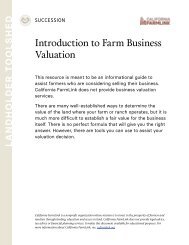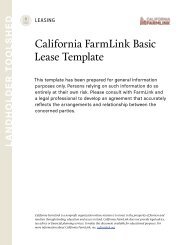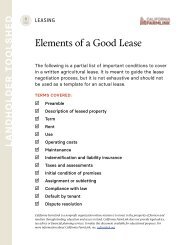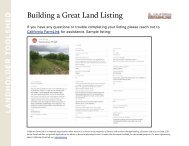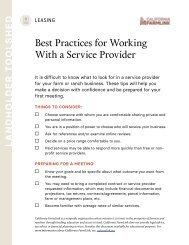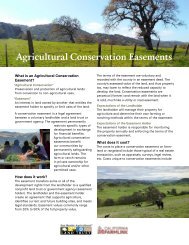Guide to Regenerative Grazing Leases: Opportunities for Resilience
California FarmLink and TomKat Ranch Educational Foundation teamed up to create this resource focused on land leases that support regenerative grazing practices. This guidebook aims to empower private, nonprofit, and public landholders, as well as easement-holders and grazing tenants.
California FarmLink and TomKat Ranch Educational Foundation teamed up to create this resource focused on land leases that support regenerative grazing practices. This guidebook aims to empower private, nonprofit, and public landholders, as well as easement-holders and grazing tenants.
Create successful ePaper yourself
Turn your PDF publications into a flip-book with our unique Google optimized e-Paper software.
CHAPTER 1. Introduction (Continued)<br />
REGENERATIVE AGRICULTURE<br />
TomKat Ranch defines regenerative agriculture as “the science, art, or occupation<br />
concerned with providing ample, nutritious food; improving local economies equitably;<br />
building soil fertility; res<strong>to</strong>ring biodiversity, water cycling, and water quality; and using<br />
natural processes <strong>to</strong> achieve climate stability by res<strong>to</strong>ring carbon and other nutrients<br />
<strong>to</strong> the soil.”<br />
Soil health is the foundation of regenerative agriculture. The four principles of soil<br />
health management—1) minimize soil disturbance, 2) maximize biodiversity, 3) keep<br />
the soil covered, 4) maintain living roots—thus <strong>for</strong>m the foundation of the principlesbased<br />
approach of regenerative agriculture.<br />
Principles of Regnerative Agriculture<br />
Each principle of regenerative agriculture is scientifically in<strong>for</strong>med, with many<br />
potential <strong>to</strong>ols and management practices <strong>to</strong> be implemented (and continually<br />
adapted) based upon one's context:<br />
1. Understand your context.<br />
Develop a sensitive and on-going relationship with the environmental, economic,<br />
and social context of the land <strong>to</strong> identify which agricultural practices produce the<br />
most <strong>to</strong>tal value relative <strong>to</strong> their full range of costs. Keep in mind that context is<br />
in a state of constant change and can vary significantly across time and space.<br />
Traditional and indigenous land management practices can be an excellent<br />
reference point as they were developed and tested over generations by people<br />
with a strong desire and necessity <strong>to</strong> maintain and enhance the health of the<br />
ecosystem while supporting thriving human communities.<br />
2. Minimize soil disturbance.<br />
Preserve the integrity and structure of soil and limit the amount of mechanical<br />
disturbance that can damage roots, harm the health and diversity of<br />
microbiological communities, and create soil compaction.<br />
3. Maximize diversity.<br />
Support biodiversity above and below ground and limit the use of practices<br />
or chemicals that can damage it. Biodiversity in rangelands is critical <strong>to</strong> their<br />
productivity and resilience. Encouraging a variety of plant species and supporting<br />
macro- and micro-biological diversity can extend growing seasons, increase<br />
resilience <strong>to</strong> extreme weather, reduce lives<strong>to</strong>ck predation and health concerns,<br />
support wildlife habitat, and enhance ecosystem function.<br />
© Copyright 2022 Cali<strong>for</strong>nia FarmLink and TomKat Ranch Educational Foundation<br />
8



